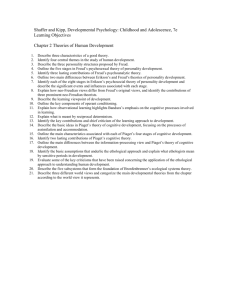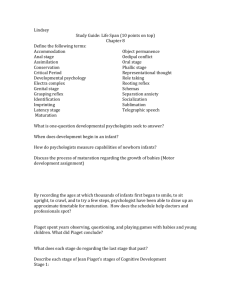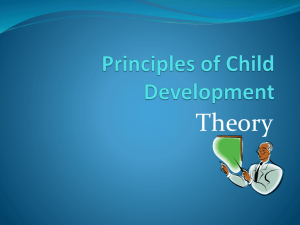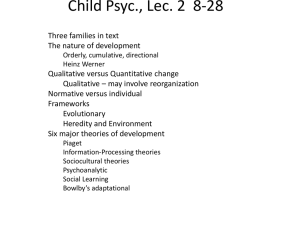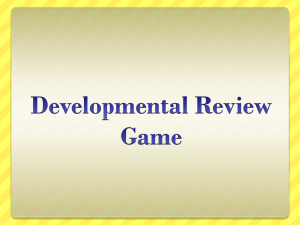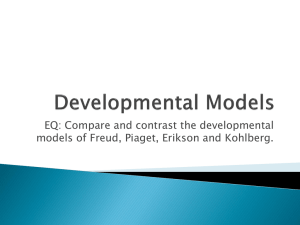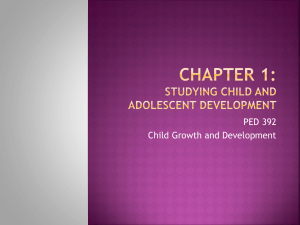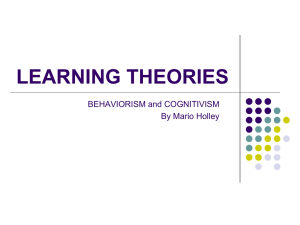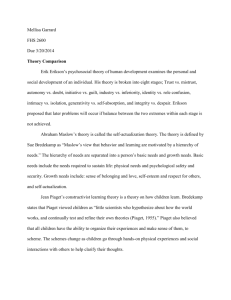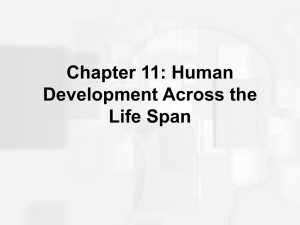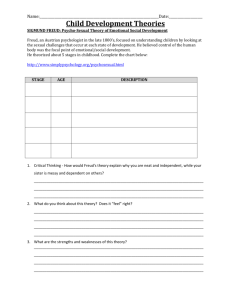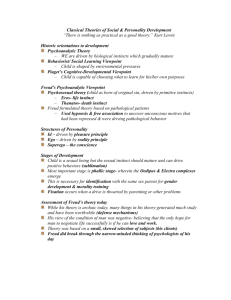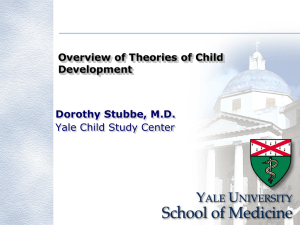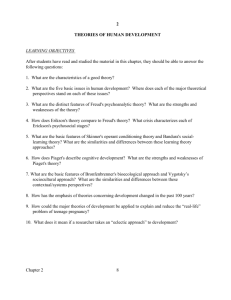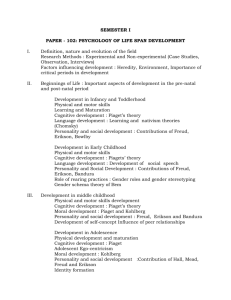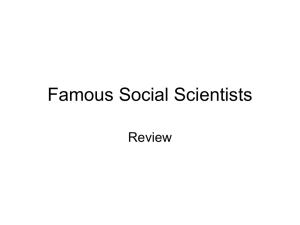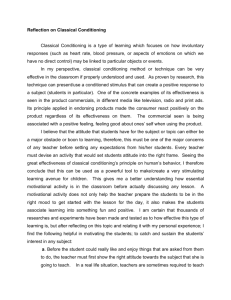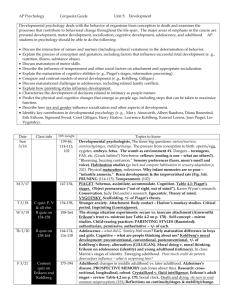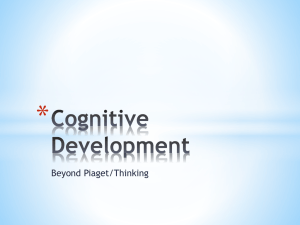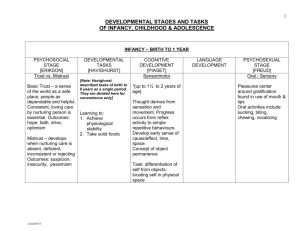Human Growth & Development Name: Chapter 2: Notes pages 33
advertisement
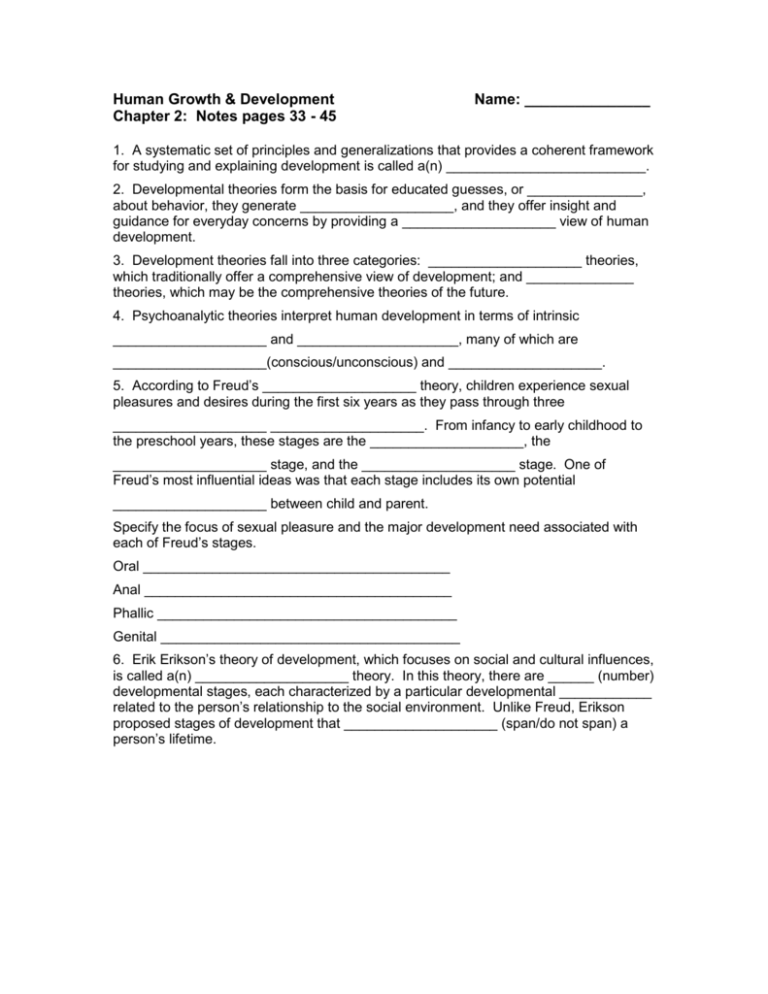
Human Growth & Development Chapter 2: Notes pages 33 - 45 Name: _______________ 1. A systematic set of principles and generalizations that provides a coherent framework for studying and explaining development is called a(n) __________________________. 2. Developmental theories form the basis for educated guesses, or _______________, about behavior, they generate ____________________, and they offer insight and guidance for everyday concerns by providing a ____________________ view of human development. 3. Development theories fall into three categories: ____________________ theories, which traditionally offer a comprehensive view of development; and ______________ theories, which may be the comprehensive theories of the future. 4. Psychoanalytic theories interpret human development in terms of intrinsic ____________________ and _____________________, many of which are ____________________(conscious/unconscious) and ____________________. 5. According to Freud’s ____________________ theory, children experience sexual pleasures and desires during the first six years as they pass through three ____________________ ____________________. From infancy to early childhood to the preschool years, these stages are the ____________________, the ____________________ stage, and the ____________________ stage. One of Freud’s most influential ideas was that each stage includes its own potential ____________________ between child and parent. Specify the focus of sexual pleasure and the major development need associated with each of Freud’s stages. Oral ________________________________________ Anal ________________________________________ Phallic _______________________________________ Genital _______________________________________ 6. Erik Erikson’s theory of development, which focuses on social and cultural influences, is called a(n) ____________________ theory. In this theory, there are ______ (number) developmental stages, each characterized by a particular developmental ____________ related to the person’s relationship to the social environment. Unlike Freud, Erikson proposed stages of development that ____________________ (span/do not span) a person’s lifetime. Complete the following chart regarding Erikson’s stages of psychosocial development. Age Period Stage Birth to 1 yr. trust vs. ____________________ 1-3 yrs. autonomy vs. ____________________ 3-6 yrs. initiative vs. ____________________ 7-11 yrs. ____________________ vs. inferiority Adolescence identity vs. ____________________ Young adulthood ____________________ vs. isolation Middle adulthood ____________________ vs. stagnation Older adulthood ____________________ vs. despair 7. A major theory in American psychology, which directly opposed psychoanalytic theory, was ____________________. This theory, which emerged early in the twentieth century under the influence of ____________________, is also called ______________ theory because of its emphasis on how we learn specific behaviors. 8. Behaviorists have formulated laws of behavior that are believed to apply ____________________ (only at certain ages/at all ages). The learning process, which is called ____________________, takes two forms: ____________________________ and ______________________________. 9. In classical conditioning, which was discovered by the Russian scientist ____________________ and is also called ____________________ conditioning, a person or an animal learns to associate a(n) ____________________ stimulus with a meaningful one. 10. According to ____________________, the learning of more complex responses is the result of ____________________ conditioning, in which a person learns that a particular behavior produces a particular ____________________, such as a reward. This type of learning is also called ____________________ conditioning. 11. The process of repeating a consequence to make it more likely that the behavior in question will recur is called ____________________. The consequence that increases the likelihood that a behavior will be repeated is called the ____________________. 12. (Thinking Like a Scientist) The behavior of infant monkeys separated from their mothers led researcher ___________________ to investigate the origins of ____________________ in infant monkeys. These studies, which demonstrated that infant monkeys clung more often to “surrogate” mothers that provided ____________________ (food/contact comfort), disproved ____________________ theory’s idea that infants seek to satisfy oral needs and ____________________ view that reinforcement directs behavior. 13. The application of behaviorism that emphasizes the ways that people learn new behaviors by observing others is called ______________________________. The process whereby a child patterns his or her behavior after a parent or teacher, for example, is called ____________________. 14. This process is most likely to occur when an observer is ____________________ or ____________________ and when the model is _____________________. This type of learning is also affected by the individual’s ____________________. Human social learning is related to ____________________, ____________________, ____________________, ____________________, and feelings of ____________________. 15. The structure and development of the individual’s thought processes and the way those thought processes affect the person’s understanding of the world are the focus of ____________________ theory. A major pioneer of this theory is ____________________. 16. In Piaget’s first stage of development, the ____________________ stage, children experience the world through their senses and motor abilities. This stage occurs between birth and age ____________________. 17. According to Piaget, during the preschool years (up to age _____________________), children are in the ____________________ stage. A hallmark of this stage is that children begin to think ____________________. Another hallmark is that sometimes the child’s thinking is ____________________, or focused on seeing the world solely from his or her own perspective. 18. Piaget believed that children begin to think logically in a consistent way at about ____________________ years of age. At this time, they enter the _______________ _______________ stage. 19. In Piaget’s final stage, the ____________________ stage, reasoning expands from the purely concrete to encompass ____________________ thinking. Piaget believed most children enter this stage by age ____________________. 20. According to Piaget, cognitive development is guided by the need to maintain a state of mental balance, called __________________________________________. 21. When new experiences challenge existing understanding, creating a kind of imbalance, the individual experiences _______________________________, which eventually leads to mental growth. 22. According to Piaget, people adapt to new experiences either by reinterpreting them to fit into, or _____________________ with, old ideas. Some new experiences force people to revamp old ideas so that they can ____________________ new experiences.
